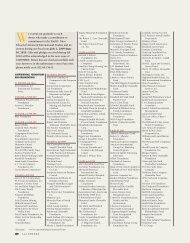Download Current Issue - SAIS
Download Current Issue - SAIS
Download Current Issue - SAIS
Create successful ePaper yourself
Turn your PDF publications into a flip-book with our unique Google optimized e-Paper software.
Conf<br />
By P. Terrence Hopmann<br />
Year of<br />
Agriculture<br />
at<strong>SAIS</strong><br />
Scholars of violent<br />
conflict, especially<br />
conflict within<br />
states, have long<br />
recognized that a<br />
sudden decline in<br />
the availability of<br />
adequate food supplies, due, for<br />
example, to extreme drought<br />
or massive flooding, can serve<br />
as the spark that sets off such<br />
conflict. This is particularly<br />
true when these catastrophes<br />
affect weak, failing or failed<br />
states that lack the institutional<br />
structures and physical<br />
infrastructure to alleviate hunger<br />
and malnutrition in the face<br />
of humanitarian emergencies.<br />
Disasters, whether natural or<br />
human, also can exacerbate<br />
existing conflicts over identity,<br />
ethnicity and inequality—and<br />
the unexpected disruption of<br />
basic commodities pushes the<br />
conflict across the threshold<br />
into large-scale violence. In<br />
states where existing conflict<br />
impedes the delivery of food<br />
to the population, food supply<br />
problems compound the miseries<br />
associated with conflict.<br />
2011–2012 33



